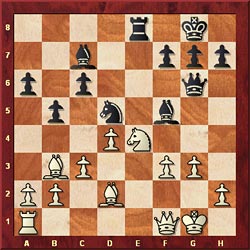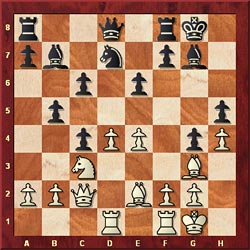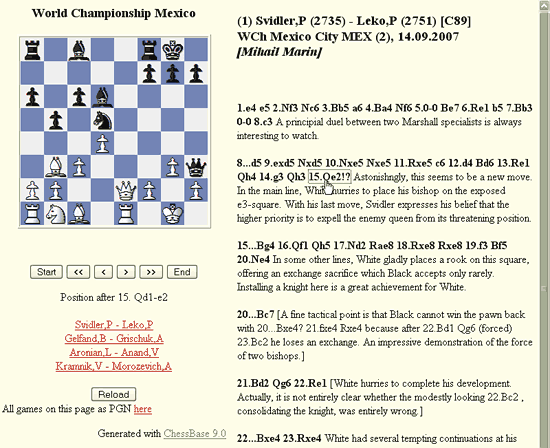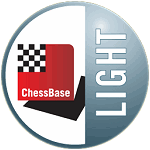
World Championship 2007 Mexico
The World Championship 2007 will take place from September 12 to 30 in the
Sheraton Centro Histórico Hotel in Mexico City. Eight players are qualified
– the tournament will be a double round robin. The prize fund is US $1.3
million.
Round two commentary
Commentary by GM Mihail Marin
A very exciting round, with sharp battles and two decisive games. Grischuk
employed a relatively rare opening plan with Black against Gelfand, who found
nothing better than carrying out a tactical operation resulting in simplifications
and a peaceful result. Svidler delivered a surprisingly early novelty against
Leko's Marshall Attack, but later failed to take advantage of what seemed to
be a favourable situation.
Anand also opened a new theory file against Aronian, by exploiting in creative
way the dark side of a well approved white plan. The Armenian star tried to
solve his problems by tactical means, but Anand's accurate reaction left him
in a joyless position. Aronian resigned after the first time control.
The star game of the evening was Kramnik-Morozevich. The World Champion gradually
tempted his opponent to grab material at the cost of neglecting his development.
Morozevich abstained himself on the first occasion, but then kindly obliged
and the position became highly irrational. Kramnik emerged out of the complications
with a clear advantage, but immediately after that offered to his opponent a
chance to come back into the game. Morozevich missed his chance and went down
quickly.

Our commentator and chess teacher GM Mihail Marin
Svidler,P (2735) - Leko,P (2751) [C89]
WCh Mexico City MEX (2), 14.09.2007 [Mihail Marin]
1.e4 e5 2.Nf3 Nc6 3.Bb5 a6 4.Ba4 Nf6 5.0-0 Be7 6.Re1 b5 7.Bb3 0-0 8.c3.
A principial duel between two Marshall specialists is always interesting
to watch. 8...d5 9.exd5 Nxd5 10.Nxe5 Nxe5 11.Rxe5 c6 12.d4 Bd6 13.Re1 Qh4
14.g3 Qh3.
15.Qe2!? Astonishingly, this seems to be a new move. In the main line,
White hurries to place his bishop on the exposed e3-square. With his last move,
Svidler expresses his belief that the higher priority is to expel the enemy queen
from its threatening position.
15...Bg4 16.Qf1 Qh5 17.Nd2 Rae8 18.Rxe8 Rxe8
19.f3 Bf5 20.Ne4. In some other lines, White gladly places a rook on this
square, offering an exchange sacrifice which Black accepts only rarely. Installing
a knight here is a great achievement for White.
20...Bc7. A fine tactical
point is that Black cannot win the pawn back with 20...Bxe4? 21.fxe4 Rxe4 because
after 22.Bd1 Qg6 (forced) 23.Bc2 he loses an exchange. An impressive demonstration
of the force of two bishops.
21.Bd2 Qg6
22.Re1. White hurries to complete his development. Actually, it is not
entirely clear whether the modestly looking 22.Bc2 , consolidating the knight,
was entirely wrong.
22...Bxe4 23.Rxe4. White had several tempting continuations
at his disposal and Svidler's choice might not be the best. For the author of
the express report is not much easier to decide which is the best way to maintain
a stable advantage and he kindly passes the responsibility of digging in for the
truth to the Chessbase Magazine 120 commentator.
23...Rxe4 24.Bc2 f5 25.fxe4
fxe4 26.Qg2 Nf6 27.Qh3 Ng4 28.Bb3+ Kf8 29.Bd1 e3 30.Bc1 h5 31.Bxg4 hxg4 32.Qf1+
Ke8 33.Bxe3 Kd7 34.Qe2 Qf5 35.b3 g6
White has won a pawn, but Black's centralized army as well as the firm control
on light squares offers him good saving chances. Besided, the white king is
passive and slightly exposed. 36.Bf2 Bd6 37.c4 bxc4 38.bxc4 Bc7 39.d5 cxd5
40.cxd5 Bd6 41.a4 Qb1+ 42.Kg2 Qf5 43.Kg1 1/2-1/2. [Click
to replay]
Gelfand,B (2733) - Grischuk,A (2726) [E15]
WCh Mexico City MEX (2), 14.09.2007 [Mihail Marin]
1.d4 Nf6 2.c4 e6 3.Nf3 b6 4.g3 Ba6 5.b3 Bb7. From the spectator's
point of view, a refreshing deviation from the ultra-fashionable 5...Bb4+ 6.Bd2
Be7. 6.Bg2 Bb4+ 7.Bd2 c5. The other possible attempt to take advantage
of the slight weakness induced by the move b3 is 7...a5. 8.Bxb4 cxb4
The only difference if compared to a popular Bogo Indian tabyia consists of White's
extra-move b3. This apparently insignificant detail not only leaves the c3-square
weak, but also deprives the white queen from the important b3-square. An old game
between two historical rivals, Karpov - Kortschnoj, Amsterdam 1987, where a genuine
Bogo Indian was played, continued 8.0-0 0-0 9.Qb3 a5 10.a3 Na6 11.Nbd2 and Black
could not activate his a6-knight under favourable circumstances.
9.0-0 0-0
10.Qd3 Be4 11.Qe3 Nc6 12.Nbd2 d5
A very interesting position, played on several occasions by Romanischin (with
black). White has a pawn majority in the centre, but the weakness of the c3-square
offers Black unexpected ideas for counterplay.
13.Rfc1 Rc8 14.cxd5 Bxd5 15.Qd3
Bxf3 16.Nxf3 Nd5 17.Rc4. Aiming to keep the rook alive before the knight jumps
to c3.
17...Nc3 18.a3
18...b5!? Grischuk refrains from the standard way of ensuring stability
to his knight, 18...a5 , because this would have allowed White to activate the
other rook as well. Instead, the tactical operation initiated with his last
move will lead to mass simplifications and a comfortable position for Black.
19.Rxc6. Forced. The generally desirable 19.Rc5? , installing the rook
on an apparently comfortable square, would lose material to 19...Nxd4! attacking
not only the rook, but also the queen (in view of the threat Ndxe2+). 19...Rxc6
20.Ng5 Qxg5 21.Bxc6 Rc8 22.Bb7 Rc7 23.axb4. After 23...Nxe2+ 24.Qxe2 Rxb7
25.Qe4, White's piece activity compensates for his slightly worse pawn structure.
1/2-1/2. [Click to replay]
Aronian,L (2750) - Anand,V (2792) [D43]
WCh Mexico City MEX (2), 14.09.2007 [Mihail Marin]
1.d4 Nf6 2.c4 e6 3.Nf3 d5 4.Nc3 c6 5.Bg5 h6 6.Bh4 dxc4 7.e4 g5 8.Bg3 b5.
An excellent way to play for a win with Black, although it should be said
that White's cooperation is needed, too. In case of 6.Bxf6 (as played just one
day earlier by Kramnik against Svidler), play takes a positional course. However,
Aronian is not the kind of player to refrain from a sharp battle, especially
when he has the white pieces. 9.Ne5 h5 10.h4 g4
Black is a pawn up, but White has a strong centre and better prospects of transferring
his king to a safe location. In the next phase of the game, both players have
to permanently take into account the standard pawn moves (White's) d5 or f3 and
(Black's) ...b4 or ...c5. For a while, however, play continues with natural developing
moves.
11.Be2 Bb7 12.0-0 Nbd7 13.Qc2 Nxe5 14.Bxe5 Bg7 15.Rad1 0-0 16.Bg3 Nd7
17.f3. This move is almost unanimously played here. White finally establishes
a centre of pawn tension and aims to open the f-file for his king's rook. The
only (but significant) drawback of this move is that it weakens the king's residence.
17...c5!? An interesting novelty. Previously, 17...Qb6 was considered
best. Anand decides that the best way of taking advantage of the vulnerability
of the enemy king is to keep the queen on her initial square. 18.dxc5.
The generally desirable 18.d5 can be strongly met by 18...Be5! when White is
in some sort of trouble: 19.Bxe5?! (After 19.f4 Bd4+ the black
dark-squared bishop is much more active than his direct rival.) 19...Nxe5
20.f4? Qxh4! with decisive attack. 18...Qe7 19.Kh1 a6 20.a4 Bc6. Black
has stabilized the position and threatens to win the c5-pawn with ...Nxc5. Since
21.Rd6 can be strongly met by 21...Be5!, White is forced to resort to radical
measures.

1.Nd5!? exd5 22.exd5. Normally, this kind of operation would yield White
an advantage... 22...Be5! ... but only with a safer king's position!
With this already familiar to us move, Anand forces his opponent to release
the kingside tension and consolidates his advantage. 23.f4 Bg7 24.dxc6 Nxc5
Both White's bishops are very passive. The c6-pawn in conjunction with certain
rook activity along the d-file will prove insufficient to level the balance.
25.Rd5 Ne4 26.Be1 Qe6 27.Rxh5 f5
White has temporarily won a pawn, but his rook is miserably placed. Anand went
on winning convincingly. 28.Kh2 Rac8 29.Bb4 Rfe8 30.axb5 axb5 31.Re1 Qf7
32.Rg5 Nxg5 33.fxg5 Rxc6 34.Bf1 Rxe1 35.Bxe1 Re6 36.Bc3 Qc7+ 37.g3 Re3 38.Qg2
Bxc3 39.bxc3 f4 40.Qa8+ Kg7 41.Qa6 fxg3+ 0-1. [Click
to replay]
Anand: "The game revolved around this move 17...c5. It's
a very interesting idea. We found it just here – Nielsen suggested it
about three days ago. Sometimes if you can surprise your opponent it is worth
almost as much as making a lot of good moves, because he has to deal with a
lot of problems over the board. He played 21.Nd5 fairly quickly, and I think
he missed this plan of 22...Be5 and 23...Bg7, or he underestimated it, I don't
know which. As you can see, in the whole game I am playing against this bishop
on e2 – my pawns on h5 and g4, and b5 and c4 control this bishop. This
turned out to be the deciding factor in the game."
Kramnik,V (2769) - Morozevich,A (2758) [E04]
WCh Mexico City MEX (2), 14.09.2007 [Marin,Mihail]
1.Nf3. When Kramnik played this move in the previous round, I thought
he might have just wanted to avoid Svidler's Grünfeld. Now, it seems that he
really switched back to the favourite weapon of his youth. 1...Nf6 2.c4 e6
3.g3 d5 4.d4. However, the Catalan is a relatively recent "discovery"
of Kramnik and his results with it have been excellent. Apparently, the subtle
combination of tactical and strategic motifs suits his talent quite well. This
game is an excellent illustration. 4...dxc4 5.Bg2 a6 6.Ne5. The more
ambitious continuation is supposed to be 6.0-0 . The text move is considered
to offer Black an equal game after 6...c5, but both Morozevich and Kramnik seem
to have a different opinion... 6...Bb4+ 7.Nc3 Nd5
Morozevich aims to put his mighty opponent under direct pressure from an early
stage of the game. This policy will soon turn against himself as a boomerang.
8.0-0!? A novelty. White simply ignores Black's apparently strong threat
and continues his development. The move is simple and logical, but its consequences
are not easy to evaluate. This often happens in the sharp lines of the Catalan:
you know exactly what you have to do, but cannot always trust your judgement,
because of the irrational character of the position.
8...0-0. This looks
like some sort of concession, after which Black's ambitious play in the previous
phase of the game loses part of its meaning. Morozevich might have feared Kramnik's
famously deep home preparation, but I must say that at first sight it is not easy
to see the danger for Black after 8...Nxc3 9.bxc3 Bxc3 . Obviously, he is strongly
underdeveloped, but for the time being he is two pawns up. Proving White's compensation
is beyond the scope of the express report, but I shall do my best to make some
adequate suggestions in CBM 120.
9.Qc2 b5 10.Nxd5 exd5
The first optical sensation is that a massive migration of Black's pieces from
the kingside to the opposite wing has taken place. Paradoxically, White will not
try to attack the slightly vulnerable king's position, but will hit precisely
on the side where Black has such an apparently strong group of forces. This is
enabled by the fact that all the queenside pieces are undeveloped yet, while the
b4-bishop is vulnerable.
11.b3 c6 12.e4. Three of Black's pawns are under
serious pressure now. Morozevich puts more wood into the fire with
12...f6
13.exd5!! Further analysis might prove that the objective merits of this move
are debatable, although I very much doubt it. (Refer to the final part of the
comment after 8.0-0). However, for the time being, I will limit myself to saying
that the enthusiastic evaluation refers to White's courage, in the best spirit
of the good old romantic times. From practical point of view, Black's position
is very difficult to play.
13...fxe5 14.bxc4. It is not easy to understand
what happens on board after these three consecutive pawn captures. Black has won
a piece for a pawn, but is strongly underdeveloped and has to avoid dxe5 somehow.
14...exd4. Four.
15.dxc6. Five.
15...Be6. Morozevich finally
starts developing his queenside. Books recommend to develop knights and only then
bishops, but how to accomplish that in this position?
16.cxb5! Kramnik
is not interested in winning the undeveloped a8-rook. He just carries out his
"plan". The immediate threat is c7; in the meanwhile, White has created
two connected pawns.
16...d3 17.c7 Qd4 18.Qa4 Nd7 19.Be3 Qd6 20.Bxa8 Rxa8
White has retrieved his material investment with some interest and preserves his
passed pawns. Still, the position remains complicated and certain accuracy is
still required.
21.Bf4? Kramnik cold have crowned his logical play by
just completing the mobilisation of his forces with 21.Rac1! which "incidentally"
threatens to promote the pawn. After 21...Rc8 22.Rc6 followed by Rxe6, White obtains
a decisive material advantage.
21...Qf8? Kindly returning the favour.
Black misses his chance to change the course of the game with 21...Qd5!! , when
22.Qxb4? is impossible because of 22...Qf3-+ , with the decisive threats ..Bd5
or ...Bh3.
22.b6!
Now it's all over. These pawns cannot be stopped. 22...Nxb6 drops a piece to
23.Qc6, while Morozevich' desperate (but delayed!) counterplay cannot change
anything. 22...Ne5 23.Bxe5 Qf3 24.Qd1 Qe4 25.b7 Rf8 26.c8Q Bd5 27.f3 1-0.
[Click to replay]
JavaScript replay
Note that on our JavaScript
replay page, to which we link after each game, you can follow
the moves by clicking on them – even in variations and analysis. The board
will follow.
You can scroll the moves and commentary on the right using the scroll bar or
your mouse wheel. The four games are listed on the left and can be loaded by
clicking them. There is also a PGN download, which will get you the games with
full commentary, to replay and analyse in Fritz or a compatible program, including
the free ChessBase Light (download link given below).
All results of the round
| Round 2: Friday, Sept. 14th 2007, 14:00h |
Peter Svidler |
½-½ |
Peter Leko |
Boris Gelfand |
½-½ |
Alexander Grischuk |
Levon Aronian |
0-1 |
Viswanathan Anand |
Vladimir Kramnik |
1-0 |
Alexander Morozevich |
| |
Current standings

Links












































